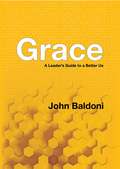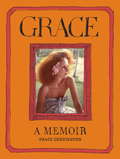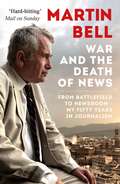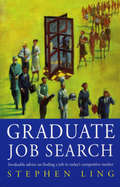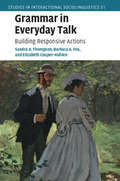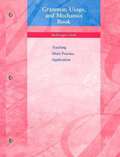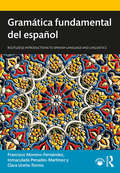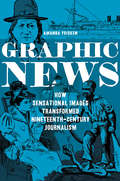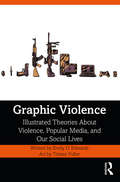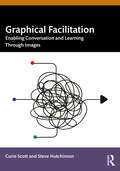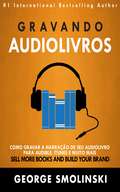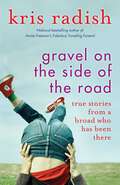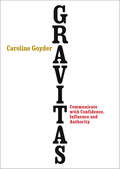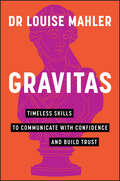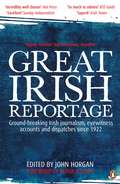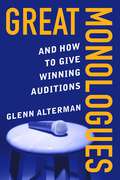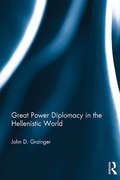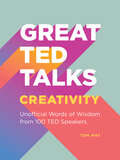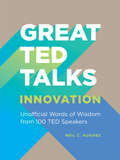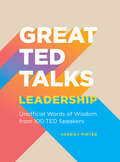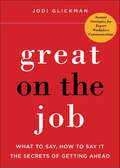- Table View
- List View
Grace: A Leaders Guide to a Better Us
by John BaldoniJohn Baldoni's new book on the power of GRACE is a must read for all of us and particularly for anyone seeking to serve in a leadership role. In a world where good manners and courtesy sometimes seem to have gone out of style, this book is a practical guide for bettering relationships in all types of human connections. John Baldoni&’s new book on the power of GRACE is a must read for all of us and particularly for anyone seeking to serve in a leadership role. In a world where good manners and courtesy sometimes seem to have gone out of style, this book is a practical guide for bettering relationships in all types of human connections. In a spiritual sense grace is unearned and as such, it is yours to use for the betterment of self and others. Grace as a gift is a catalyst for positive change to enable the greater good. Baldoni&’s GRACE mixes stories of everyday heroes with interviews of notable thought leaders. The results give practical insights into generosity, respect, and compassion coupled with the energy and actions it takes to deliver on these virtues. Creating an acronym, Baldoni helps us distinguish the attributes of grace in Generosity, Respect, Action, Compassion and Energy. We can apply these universal truths in ordinary as well as extraordinary situations. The many examples of grace in everyday life allow us to witness human dignity and humility and remind us what wonders we can accomplish when working together. This is an inspiring collection of personal stories that combines wisdom with positive outcomes.
Grace: A Memoir
by Grace CoddingtonBeautiful. Willful. Charming. Blunt. Grace Coddington's extraordinary talent and fierce dedication to her work as creative director of Vogue have made her an international icon. Known through much of her career only to those behind the scenes, she might have remained fashion's best-kept secret were it not for The September Issue, the acclaimed 2009 documentary that turned publicity-averse Grace into a sudden, reluctant celebrity. Grace's palpable engagement with her work brought a rare insight into the passion that produces many of the magazine's most memorable shoots. With the witty, forthright voice that has endeared her to her colleagues and peers for more than forty years, Grace now creatively directs the reader through the storied narrative of her life so far. Evoking the time when models had to tote their own bags and props to shoots, Grace describes her early career as a model, working with such world-class photographers as David Bailey and Norman Parkinson, before she stepped behind the camera to become a fashion editor at British Vogue in the late 1960s. Here she began creating the fantasy "travelogues" that would become her trademark. In 1988 she joined American Vogue, where her breathtakingly romantic and imaginative fashion features, a sampling of which appear in this book, have become instant classics. Delightfully underscored by Grace's pen-and-ink illustrations, Grace will introduce readers to the colorful designers, hairstylists, makeup artists, photographers, models, and celebrities with whom Grace has created her signature images. Grace reveals her private world with equal candor--the car accident that almost derailed her modeling career, her two marriages, the untimely death of her sister, Rosemary, her friendship with Harper's Bazaar editor-in-chief Liz Tilberis, and her thirty-year romance with Didier Malige. Finally, Grace describes her abiding relationship with Anna Wintour, and the evolving mastery by which she has come to define the height of fashion. "If Wintour is the Pope . . . Coddington is Michelangelo, trying to paint a fresh version of the Sistine Chapel twelve times a year."--TimeFrom the Hardcover edition.
Grade B Reporter: Reflections of a Grade B Reporter
by Martin BellMartin Bell has stood in war zones as both a soldier and a journalist. From Vietnam to Bosnia to Iraq, he has witnessed first-hand the dramatic changes in how conflicts are fought and how they are reported. He has seen the truth degraded in the name of balance and good taste – grief and pain censored so the viewers are not disturbed. In an age of international terror, where journalists themselves have become targets, more and more reports are issued from the sidelines. The dominance of social media has ushered in a post-truth world: Twitter rumours and unverifiable videos abound, and TV news seeks to entertain rather than inform. In this compelling account, one of the outstanding journalists of our time provides a moving, personal account of war and issues an impassioned call to put the substance back in our news.
Graduate Job Search
by Stephen LingWe are experiencing a substantial rise in the graduate population just at a time when the suply of suitable jobs is stagnant. There is competition for jobs providing relevent proffessional experience, and graduates are having to be willing to move jobs to capitalise on their experience. This is a detailed and comprehensive book which helps graduates to plan a job search campaign from the preparing for the 'milk round' of prospective employers, to choosing the job which is right for you, composing an effective CV, doing some research about the companies which interest you and honing your interveiw skills.
Graf von Anderson's College German Grammar and Culture
by Christian AndersonGraf von Anderson’s College German Grammar and Culture is a beginners’ textbook (CEFR A1-B2, ACTFL novice low – intermediate low) for the German language for college students and for those engaged in self-study with popular software programs and apps. In addition to illuminating profiles of key places and individuals who helped shape German history from Roman times to the present day, the textbook also includes important cultural briefings. Chapter by chapter the book delineates the scope of the German language, beginning with “ich”, and moving on to subjects and verbs. Later chapters introduce cases, indirect and direct objects, prepositions, tenses, moods, and adjectives. Each chapter includes challenging exercises, and an answer key is provided. The rich cultural component in each chapter includes a travel guide, a historical snapshot, several musical selections, and a German text to read. This book is a straightforward and thorough introduction to the basic structures of German grammar and provides an overview of selected highlights of German culture to engage and enthuse.
Grammar in Everyday Talk: Building Responsive Actions (Studies in Interactional Sociolinguistics)
by Sandra A. Thompson Barbara A. Fox Elizabeth Couper-KuhlenDrawing on everyday telephone and video interactions, this book surveys how English speakers use grammar to formulate responses in ordinary conversation. The authors show that speakers build their responses in a variety of ways: the responses can be longer or shorter, repetitive or not, and can be uttered with different intonational 'melodies'. Focusing on four sequence types: responses to questions ('What time are we leaving?' - 'Seven'), responses to informings ('The May Company are sure having a big sale' - 'Are they?'), responses to assessments ('Track walking is so boring. Even with headphones' - 'It is'), and responses to requests ('Please don't tell Adeline' - 'Oh no I won't say anything'), they argue that an interactional approach holds the key to explaining why some types of utterances in English conversation seem to have something 'missing' and others seem overly wordy.
Grammar, Usage, and Mechanics Book, Grade 7: Teaching More Practice Application
by McDougal-Littell Publishing StaffGrammar, Usage, and Mechanics Book Grade 7 contains a wealth of skill-building exercises. Each lesson has different levels of worksheets. Teaching introduces the skill; More Practice and Application extend the skill with advanced exercises. Each page focuses on one topic or skill. A brief instructional summary on the Teaching page is followed by reinforcement activities. Key words and phrases are highlighted for greater clarity and ease of use. When appropriate, example sentences demonstrate how to complete exercises.
Gramática fundamental del español
by Francisco Moreno-Fernández Inmaculada Penadés-Martínez Clara Ureña-TormoGramática fundamental del español abarca una amplia gama de temas relacionados con la morfología, la sintaxis y la escritura del español. Usando ejemplos contextualizados y atendiendo a la dimensión cognitiva, esta gramática presenta diferentes maneras de entender numerosos aspectos básicos del uso y el significado de la gramática, incluyendo: frases, cláusulas y oraciones clases de palabras y tipos de oraciones gramática de la palabra construcción y análisis de oraciones gramática y escritura Esta obra incluye información gramatical sobre las variedades más generales del español. También proporciona un amplio conjunto de ejercicios, las soluciones a los ejercicios y un índice de materias y términos gramaticales. Esta gramática es una lectura clave para los estudiantes de español y de estudios hispánicos entre los niveles intermedio-bajo y avanzado-alto de ACTFL o bien entre los niveles B1 y C2, si se sigue el CEFR.
Graphic News: How Sensational Images Transformed Nineteenth-Century Journalism (History of Communication #148)
by Amanda Frisken”You furnish the pictures and I’ll furnish the war.” This famous but apocryphal quote, long attributed to newspaper magnate William Randolph Hearst, encapsulates fears of the lengths to which news companies would go to exploit visual journalism in the late nineteenth century. From 1870 to 1900, newspapers disrupted conventional reporting methods with sensationalized line drawings. A fierce hunger for profits motivated the shift to emotion-driven, visual content. But the new approach, while popular, often targeted, and further marginalized, vulnerable groups. Amanda Frisken examines the ways sensational images of pivotal cultural events—obscenity litigation, anti-Chinese bloodshed, the Ghost Dance, lynching, and domestic violence—changed the public's consumption of the news. Using intersectional analysis, Frisken explores how these newfound visualizations of events during episodes of social and political controversy enabled newspapers and social activists alike to communicate—or challenge—prevailing understandings of racial, class, and gender identities and cultural power.
Graphic Violence: Illustrated Theories about Violence, Popular Media, and Our Social Lives
by Emily EdwardsGraphic Violence provides an innovative introduction to the relationship between violence and visual media, discussing how media consumers and producers can think critically about and interact with violent visual content. It comprehensively surveys predominant theories of media violence and the research supporting and challenging them, addressing issues ranging from social learning, to representations of war and terrorism, to gender and hyper-masculinity. Each chapter features original artwork presenting a story in the style of a graphic novel to demonstrate the concepts at hand. Truly unique in its approach to the subject and medium, this volume is an excellent resource for undergraduate students of communication and media theory as well as anyone interested in understanding the causes and effects of violence in media.
Graphical Facilitation: Enabling Conversation And Learning Through Images
by Steve Hutchinson Curie ScottIf ‘a picture is worth a thousand words,’ this book provides an approach to help create professional pictures that productively and powerfully capture conversations and thinking for individual and collective learning. Individuals are bombarded by information, and organizations, managers, and teachers often lack a corresponding set of tools to make sense of this complexity—resulting in far too many “death by bullet-point” presentations. This is that toolkit, also offering invitations to readers to extend their thinking past these tools to enable the creation (and co-creation with teams, learners, and clients) of graphical depictions, models, and metaphors to help people make sense of their world. This accessible book is constructed as a visual reference so readers can quickly pick out the specific tool or strategy they need, whether working with individuals and teams to promote self-awareness, develop emotional intelligence, improve communication, or articulate vision and strategy.This clear and adaptable guide will be a welcome resource for teachers, trainers, managers, and coaches to empower people to learn, think, and create in a powerful, memorable, and graphical way.
Gravando audiolivros: Como gravar a narração de seu audiolivro para Audible, iTunes e muito mais
by George Smolinski Mariana BaroniComo gravar a narração de seu audiolivro para a Audible, o iTunes e muito mais! Venda mais livros e construa sua marca! Áudio está na moda! Não é nenhum segredo que, seja por podcasts ou em audiolivros, as pessoas queiram escutar a conteúdo tanto quanto queiram vê-lo ou lê-lo. Comece a gravar seu próprio audiolivro com este livro! Este é um guia completo com instruções em vídeo que permitirão que você grave seu próprio audiolivro. Eu sei porque usei ESSAS MESMAS TÉCNICAS PARA GRAVAR este mesmo livro para a Audible! Os audiolivros são a maior tendência em publicação hoje. Houve um crescimento explosivo nas vendas de audiolivros nos últimos 4 anos e você precisa transformar seu livro em formato audiolivro hoje. Este guia o ensinará os prós e contras da gravação de audiolivros, mesmo se você quiser gravar sozinho a narração de seu audiolivro. O que este guia discutirá: 1. Qual equipamento você precisará para gravar seus audiolivros e narrações; 2. Como começar a gravar audiolivros com os software GarageBand e Audacity; 3. Dicas e truques que o ajudarão a começar com o pé direito a narração do audiolivro; 4. Como fazer upload de seu livro finalizado para Audible e o iTunes; 5. Recursos úteis para terceirizar a produção de seu audiolivro se você não for do tipo “faça você mesmo”. Entre na onda dos audiolivros e aprenda como gravar os seus hoje mesmo!
Gravel on the Side of the Road: True stories from a broad who has been there
by Kris RadishA woman who worries about carrying a .38 special in her purse, nearly drowns in a desert canyon, flies into the war in Bosnia, dances with the FBI, tells Geraldo he shouldn't put guests in hotel rooms with rats and spends time with murderers, has more than a few stories to tell. Gravel on the Side of the Road: True Stories From a Broad Who Has Been There is a daring and revealing adventure itself. Beloved novelist Kris Radish returns to her non-fiction beginnings with her first book of autobiographical essays.
Gravitas: Communicate with Confidence, Influence and Authority
by Caroline GoyderHave you ever wondered why some people earn attention and respect when they speak and others don't? The secret to their success can be summed up in one word: gravitas. In this revolutionary new book, leading voice coach and speaker Caroline Goyder reveals how to speak so others will listen. Through simple techniques to build your natural gravitas, you will learn how to express yourself clearly with passion and confidence to persuade, influence and engage listeners. By being grounded in your values and capabilities, you will gain the authority needed to make people sit up and pay attention.Each chapter guides you step-by-step through practical techniques and exercises to give you the skills for great presentations, productive meetings and persuasive pitches. You'll overcome anxiety, learn how to deal with difficult people and feel calm and in control when public speaking. An essential tool for the modern workplace, Gravitas will transform the way you think about yourself and your powers of communication.
Gravitas: Timeless Skills to Communicate with Confidence and Build Trust
by Louise MahlerBoost your confidence and transform your speaking skills with wisdom from the ancients What does the word ‘gravitas’ mean today? In the world of ancient Rome, it was the manner of trust and respect cultivated by capable, strong leadership. In Gravitas: Timeless Skills to Communicate with Confidence and Build Trust, communications expert Louise Mahler shows how this ancient virtue can help you rethink modern communication and transform your presence and impact as a leader today. Gravitas unpacks the essential speaking skills, strategies and techniques that great leaders use to communicate effectively. This book reveals the ways and means that were essential two thousand years ago and remain essential today. You’ll learn how to better connect with your audience and persuade them to trust in you and your ideas. From the wisdom of ancient leaders such as Cicero and Quintilian, you’ll discover powerful frameworks for mindset and the critical skills of delivery. Harness your posture, your eyes, your voice, your gestures and even your breathing for maximum impact, whether you’re in a one-on-one meeting or engaging a large crowd. Beat imposter syndrome: build your confidence as a public speaker Prove yourself as a capable leader with a strong presence Learn how to gain the trust of your team and clients Give standout presentations and speak confidently in any business situation, including meetings, sales pitches, proposals, boardrooms, town halls, conferences, and even in the media Learn how gravitas works for women and how to harness it for exceptional communicating as a female leader It’s time to rediscover our lost skills and revitalise the art of communication. The ancient Romans brought their people together and conquered the known world. With Gravitas, you’ll draw on their wisdom and skills to conquer doubt and uncertainty. By cultivating your own gravitas, you’ll be able to build trust effectively — and communicate any message clearly and with confidence.
Great Irish Reportage
by John HorganReports and dispatches from Ireland's finest writers: the first-ever anthology of Irish reportage.Alongside its world-famous tradition of great fiction, Ireland has a less well known but thrilling tradition of reportage: journalism, dispatches and eyewitness accounts. From Elizabeth Bowen to Colm Toibin, from Flann O'Brien to Maeve Binchy, some of Ireland's greatest writers have produced first-rate journalism. And from R.M. Smyllie and Conor Cruise O'Brien to Eamon Dunphy and Olivia O'Leary, Ireland has also produced a remarkable number of journalists who can really write. Now, for the first time, the best of Irish reportage - some of it legendary, some of it unjustly forgotten - is gathered into a single volume. Whether it's Kate O'Brien on the reinterment of W.B. Yeats or Emily O'Reilly on the election to Westminster of Gerry Adams, whether it's Hubert Butler on the Fetherd-on-Sea boycott or Joseph O'Connor at the 1994 World Cup, the pieces in Great Irish Reportage illuminate Irish life in a way that no other form of writing can.'There is so much to admire and digest between the covers ... All of them put you right there, right on the frontline, right in the moment' RTE Guide 'You'll learn much about this great little nation of ours, and what makes it tick, from this incredibly well chosen collection' Hot Press 'There are superb examples of reportage here that combine hard fact and descriptive narrative' Irish Times'Excellent ... In such time, the need for brave individuals to believe in the power of the words they write is essential. Despite changes in the media landscape in recent years ... it appears as if that hunger from journalists, to question, inspire, and hold those who we democratically elect to accountability, is as strong as ever' Sunday Independent 'Probably unbeatable for showing how Ireland has changed ... The editor has done a remarkable job' Irish Catholic
Great Monologues: And How to Give Winning Auditions
by Glenn AltermanA must-have resource for aspiring actors: both monologues to audition with and a step-by-step guide on the best monologue audition preparation!Great Monologues: And How to Give Winning Auditions is primarily for actors looking for excellent acting monologues for their monologue auditions. There are original monologues written specifically for auditions, as well as monologues from award-winning playwright Glenn Alterman&’s plays. There are comedic, dramatic, and serio-comedic monologues for all audition calls.Great Monologues also offers a step-by-step process to prepare for all monologue auditions. The monologues offered run from one minute to five minutes, thus covering all audition times. There are also a number of in-depth interviews with major casting directors, directors, and theatre company artistic directors. If you are an aspiring actor in need of an audition monologue, or want the best advice on how to properly audition with a monologue, Great Monologues: And How to Give Winning Auditions is a must-have in your collection!Allworth Press, an imprint of Skyhorse Publishing, publishes a broad range of books on the visual and performing arts, with emphasis on the business of art. Our titles cover subjects such as graphic design, theater, branding, fine art, photography, interior design, writing, acting, film, how to start careers, business and legal forms, business practices, and more. While we don't aspire to publish a New York Times bestseller or a national bestseller, we are deeply committed to quality books that help creative professionals succeed and thrive. We often publish in areas overlooked by other publishers and welcome the author whose expertise can help our audience of readers.
Great Negotiations
by Fredrik StantonWords as much as weapons have shaped the course of history. Whether to avert, resolve, assist, or secure the outcome of a conflict, diplomacy in the modern age has had great triumphs and bitter failures, from the Cuban Missile Crisis in 1962, which narrowly spared humanity from a nuclear Armageddon, to the Treaty of Versailles after World War I, which created problems that still confront us today. Drawing on primary sources, transcripts, and interviews, Great Negotiations: Agreements that Changed the Modern World tells the stories of eight key episodes in modern diplomacy. From Benjamin Franklin securing crucial French support for the American revolution to Reagan and Gorbachev laying the groundwork to eliminate an entire class of nuclear weapons, Fredrik Stanton explains what each party brought to the negotiating table, the stakes, the obstacles to success, and how they were overcome.
Great PR: Bullet Guides
by Brian SalterWhat's in this book?Open this book and you will... - Improve communication - Foster development - Establish goals - Encourage successLearn how to be a mentor:- Understanding mentoring- The mentoring process- Successful mentoring relationships- Skills for successful mentors and mentees- Common pitfalls- The benefits of mentoring- Advice about giving advice- Bringing it to a successful closeSample page spread: What are Bullet Guides?The answers you need - now.Clear and concise guides in a portable format. Information is displayed in an easy-to-read layout with helpful images and tables. Bullet Guides include all you need to know about a subject in a nutshell. Get right to the point without wading through loads of unnecessary information.
Great PR: Bullet Guides
by Brian SalterWhat's in this book?Open this book and you will... - Improve communication - Foster development - Establish goals - Encourage successLearn how to be a mentor:- Understanding mentoring- The mentoring process- Successful mentoring relationships- Skills for successful mentors and mentees- Common pitfalls- The benefits of mentoring- Advice about giving advice- Bringing it to a successful closeSample page spread:What are Bullet Guides?The answers you need - now.Clear and concise guides in a portable format. Information is displayed in an easy-to-read layout with helpful images and tables. Bullet Guides include all you need to know about a subject in a nutshell. Get right to the point without wading through loads of unnecessary information.
Great Power Diplomacy in the Hellenistic World
by John D GraingerDiplomacy is a neglected aspect of Hellenistic history, despite the fact that war and peace were the major preoccupations of the rulers of the kingdoms of the time. It becomes clear that it is possible to discern a set of accepted practices which were generally followed by the kings from the time of Alexander to the approach of Rome. The republican states were less bound by such practices, and this applies above all to Rome and Carthage. By concentrating on diplomatic institutions and processes, therefore, it is possible to gain a new insight into the relations between the kingdoms. This study investigates the making and duration of peace treaties, the purpose of so-called 'marriage alliances', the absence of summit meetings, and looks in detail at the relations between states from a diplomatic point of view, rather than only in terms of the wars they fought. The system which had emerged as a result of the personal relationships between Alexander's successors, continued in operation for at least two centuries. The intervention of Rome brought in a new great power which had no similar tradition, and the Hellenistic system crumbled therefore under Roman pressure.
Great TED Talks Creativity: An Unofficial Guide with Words of Wisdom from 100 TED Speakers (Great TED Talks)
by Tom MayInsights and advice on the creative process from 100 prominent TED Conference speakers. Online TED Talks have provided inspiration to a worldwide audience since 2006, focusing not only on subjects of technology, entertainment, and design but also on cultural, social, and political issues. Great TED Talks: Creativity gathers the ideas presented by 100 speakers and condenses them into a nutshell of practical advice for boosting your own creativity. Also included are URLs directing readers to the TED website so they can watch the original videos in their entirety.
Great TED Talks Innovation: An Unofficial Guide with Words of Wisdom from 100 TED Speakers (Great TED Talks)
by Neil C. HughesBecome more innovative by applying the ideas of 100 prominent TED Conference speakers to your own life.Great TED Talks: Innovation features words of wisdom from 100 speakers and condenses their ideas into accessible advice for becoming more innovative in how you approach and organize your life. Since 2006, online TED Talks have provided inspiration to a worldwide audience. Besides subjects like technology, entertainment, and design, TED Talks also focus on cultural, social, and political issues. Included in each section are URLs directing readers to the TED website so they can watch the original videos in their entirety.
Great TED Talks Leadership: An Unofficial Guide with Words of Wisdom from 100 TED Speakers (Great TED Talks)
by Harriet MinterThe words of 100 prominent TED Conference speakers will help you achieve your personal and professional goals. In 2006, TED Talks became accessible online, and have since been viewed more than a billion times by people across the world. Great TED Talks: Leadership highlights the words of 100 TED Conference speakers and discusses how their ideas can be applied to your own life. Whether you’re a leader of a business group or the organizer of a small social club, the advice in this book will help you visualize and achieve your goals. Included in each section are URLs directing readers to the TED website so they can watch the original videos in their entirety.
Great on the Job: What to Say, How to Say It: The Secrets of Getting Ahead
by Jodi GlickmanGreat on the Job offers a much-needed "people skills" primer and masterclass in all facets of workplace communicationDo you know how to ask for help at work without sounding dumb? Do you know how to get valuable and useful feedback from your colleagues? Have you mastered your professional elevator pitch so that every time you meet someone, they remember and are impressed by you? If you answered "no" to any of these questions, you need Great on the Job. In 2008, Jodi Glickman launched Great on the Job, a communications consulting firm whose distinguished client list includes Harvard Business School, Wharton, The Stern School of Business, Merrill Lynch, and Citigroup. Now, Glickman's three-step training program is available in book form for the first time. With case studies, micro strategies, and example language, readers will learn communication skills that can be practiced and implemented immediately. In today's economy, it's not typically the smartest, hardest working or most technically savvy who succeed. Instead, the ability to communicate well is often the most important precursor to success in the workplace. So whether you're a star performer or a struggling novice, Great on the Job will give you the building blocks you need for every conversation you'll have at work.
